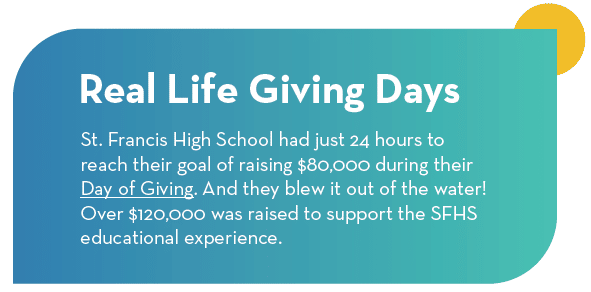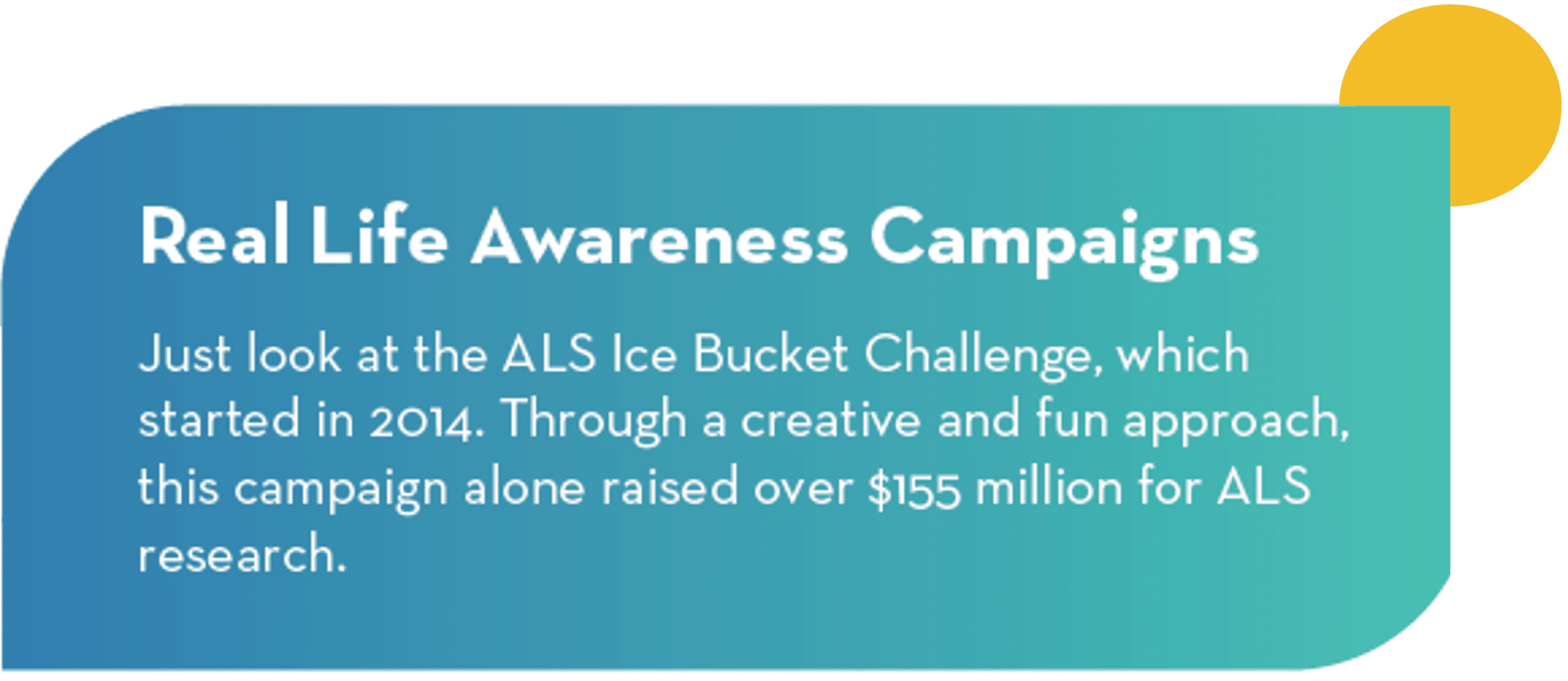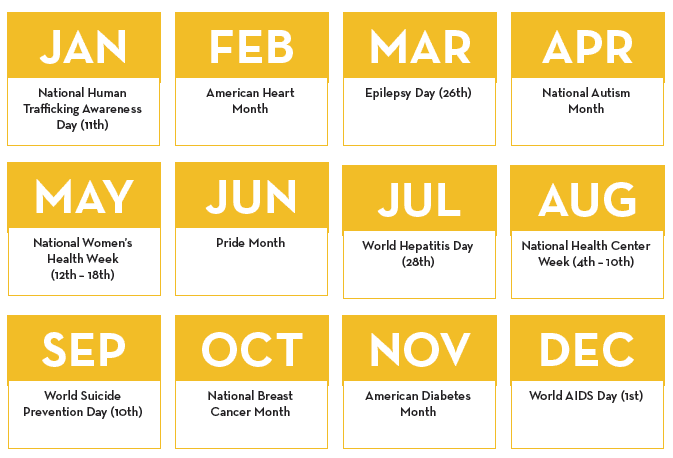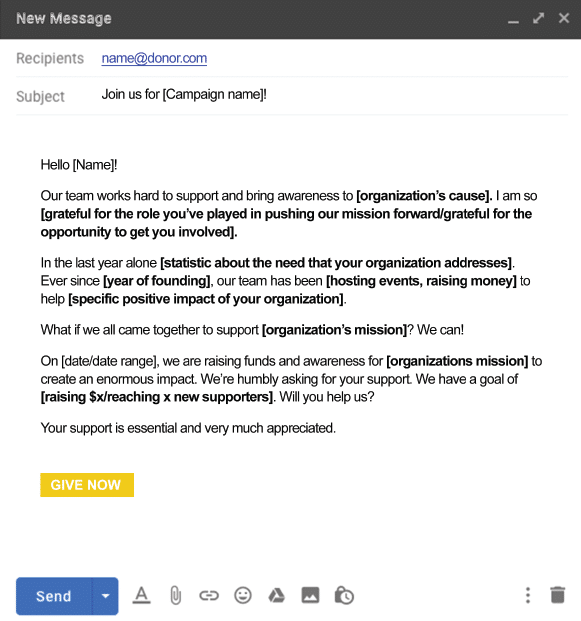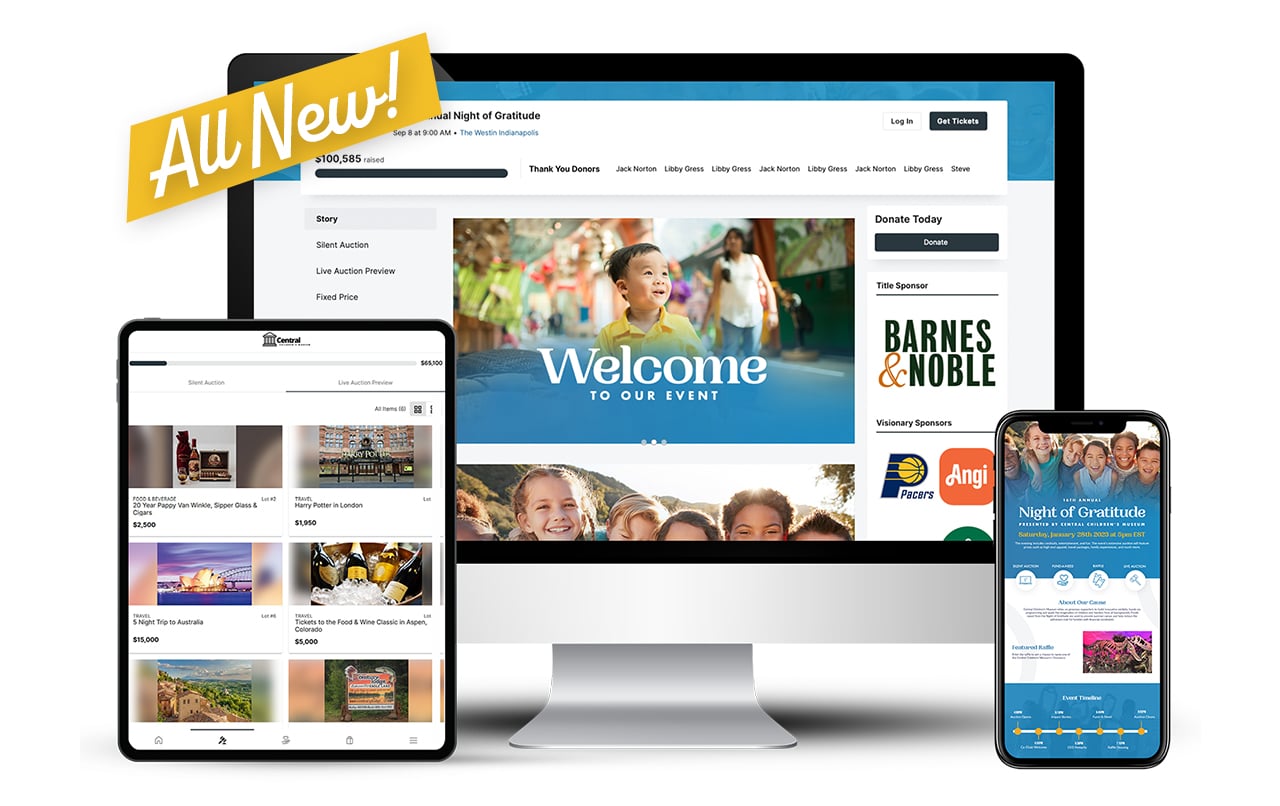Ultimate Guide to Giving and Awareness Days
At OneCause, we know that nonprofit fundraising requires a smart, strategic approach. That’s why we created a year-round fundraising platform that allows nonprofits to engage with more donors, save time, and raise more money to power their missions. If you look at any of the 365 days in the year, there are dozens of Giving and Awareness Days associated with specific causes. From #GivingTuesday (the first Tuesday after Thanksgiving) to World Mental Health Day (October 10), Giving and Awareness Days are dedicated fundraising campaigns that unite communities – both local and worldwide – around charitable giving.
These campaigns are about raising money for your mission, engaging with existing donors, and identifying new supporters.
This number represents an exciting opportunity for nonprofits to broaden their donor base and increase awareness of and support for their mission. But, regardless of your mission, captivating the attention of your audience (and then motivating them to give) can be a major challenge for nonprofits. That’s why we’ve compiled this complete guide! It provides all the basics that your nonprofit needs to make our next campaign easy and successful. Here’s what we’ll cover:
What is a Giving Day?
If your nonprofit is like most charitable organizations, you’ve probably started thinking about taking advantage of a dedicated Giving Day in the upcoming year.
These day-long campaigns bring awareness to your mission and empower donors to give online. It’s like creating a virtual army, mobilized for fundraising! Giving Days are increasingly popular with nonprofits who want to think outside the box and reach their supporters online.
While awareness campaigns (like Autism Awareness Month or Breast Cancer Awareness Month) target larger audiences for sustained periods of time, Giving Days narrow the focus to a single 24-hour period. This allows nonprofits to channel donations into one day – creating urgency and fun for the cause.
Giving Days can be standalone (unique to your nonprofit) or piggyback off the many local or regional Giving Days already in place. For nonprofits, these campaigns present an opportunity to activate volunteers, employees, board members, and supporters to donate to your mission and create focused impact.
Why Host a Giving Day?
The beauty of Giving Days is they are relatively easy to execute. Because they are online, they don’t carry the same logistical needs as a traditional fundraising auction or on-the-ground event.
Another unique advantage to Giving Days is they allow nonprofits to leverage mobile fundraising, social media, and ambassador fundraising to fully engage social networks and reach more supporters, anywhere and at any time.
But the benefits aren’t one-sided. Giving Days are also exciting and engaging for donors. Because there is a hard deadline associated with Giving Days, they create sense of competition and urgency to increase donations and meet giving goals before the clock runs out.
Planning and Executing Your Giving Day
Like any successful fundraiser, Giving Days require planning and preparation. The biggest consideration: make sure you allow enough time to ‘hype’ and promote your campaign.
Planning in advance, optimizing your promotion and marketing plan, and prepping for the actual day can jump-start a successful campaign.
6 Months Out
- Set your Giving Day goals. How much do you want to raise? Are you going to offer other promotions?
Select, implement, and start using your fundraising software. Begin planning your online, social, and peer-to- peer campaigns. - Build a list of potential sponsors, community members, ambassadors and VIP supporters that can help increase donations or help spread the word.
- Create impact statements – we know Social Donors love to feel connected to a cause, so be sure map out how each giving level impacts your mission.
- Start spreading the word and promoting your Giving Day! Contact any news or press outlets with the story, post on social media, and ask supporters to start sharing the news.
1-3 Months Out
- Make sure your staff, leadership, board members, and volunteers know what they’re responsible for during the Giving Day, whether it’s updating social channels or calling supporters directly.
- Ramp up promotions. Send out emails to supporters, update your website, and ask partners to include your promo in their content.
- Engage Ambassadors and other top supporters in your online and social campaigns.
- Engage your supporters with peer-to-peer campaigns and encourage them set up their own microsites. That way they can fundraise on your behalf!
1 Week Out
- Add a widget to your website that counts down the time until your Giving Day officially kicks off!
- Do a last minute test of your website, donation forms, and Text2Give workflows. Check all of your links and scheduled social posts.
- Build a thank you page and thank you messaging to post as soon your Giving Day is over.
Day Of!
- Hit social media hard! Build engagement organically in your posts. Include your hashtag and donation links in your posts, and be sure to like and reply to those who tag your organization or use your hashtag in their posts.
- Make sure your calls to action are clear, easy to understand, and included in every single message or social post.
- Check in on your board and leadership team to make sure they’re posting and engaged.
- Post public updates throughout the day. Be sure to announce milestones, matching gifts, and donation totals as you get closer to meeting your goal.
- Finally, say ‘thank you!’ Be sure to showcase loyal donors and major gifts, but—most importantly—communicate the IMPACT they’ll have on your mission.
What is An Awareness Campaign?
An Awareness Campaign is any time-bound, strategic campaign aimed entirely at increasing public visibility and awareness for your cause. For nonprofit organizations, this means planning a campaign to spread the word about your mission, explain why it matters, and show supporters how they can get involved.
In today’s social media focused world, hosting Awareness Campaigns is an impactful way to spread your mission and engage new audiences. In recent years, Awareness Campaigns have become one of the fastest-growing nonprofit campaigns. And for good reason – they work!
The main goal of an Awareness Campaign is to raise visibility for your mission. By spreading awareness of your nonprofit’s cause, you’ll grow your audience and create a stronger base of support to drive your mission forward.
However, it can be difficult to measure “raising awareness” as a concrete goal. This is why many nonprofits choose specific key performance indicators (KPIs) to gauge the success of their awareness strategies. Common goals for Awareness Campaigns involve audience growth and digital engagement.
Generating donations isn’t a core goal of Awareness Campaigns. While your Awareness Campaign likely will result in increased donations to your nonprofit, fundraising shouldn’t be the central purpose. Keep the focus on spreading the word and showing a wider audience why your work matters – the donations will follow!
Why Host an Awareness Campaign?
If your nonprofit wants to grow its audience and expand your base of support, an Awareness Campaign is the right move for you. Awareness Campaigns are extremely flexible. You can mix-and-match a variety of strategies and digital tactics to reach and engage your audience.
Common strategies include:
- Social media campaigns and viral challenges
- Multichannel marketing strategies
- Peer-to-peer fundraising and ambassador campaigns
- Virtual awareness events
- Partnerships with other local organizations
If you’re strategically thinking ahead, growing your audience a year or more before a major expansion project or capital campaign can help you build a stronger foundation for future growth – meaning one Awareness Campaign can benefit your organization for years to come!
Examples of Awareness Days, Weeks, & Months
There are hundreds of Awareness Days, but the most effective, impactful organizations are the ones that break through noise and engage with audiences on a deeper level.
Your campaign doesn’t have to sync up with a national awareness month, but it can help! For example, Breast Cancer Awareness is already top-of-mind for your supporters in October. That would be the perfect time for an organization who supports breast cancer research to do an Awareness Campaign!
Planning and Executing Your Awareness Campaign
When it comes to Awareness Campaigns, timelines are key!
To be successful, you need to plan out the right messaging, to the right people, at the right time. And to stand out from the competition, your supporters need to know as soon as possible when the campaign will be so that they can prepare.
3-6 Months Out
- Choose, set up, and utilize your fundraising technology. Determine how you are using mobile and peer-based fundraising in your efforts.
- Have a plan for developing partnerships and attracting influencers that will help you spread the word. Are there any local businesses or other nonprofits in the area that would be open to partnering to increase awareness?
- Approach VIP donors and attendees to ask for their support, attendance, and ask them for their support and involvement.
- Begin your marketing efforts. Brand your campaign, create a logo and tagline, and start spreading the word.
- Start your PR efforts. Submit articles and announcements to local press outlets.
- Begin promoting your campaign. Send out save-the-date emails and postcards and launch your social media campaign. Include mission-focused messaging in all communications.
1-2 Months Out
- Determine your day, week, and month-of execution plan. Assign staff responsibilities so everyone knows exactly what they should be doing, and ensure all logistics (event,
media, etc.) are confirmed and ready to go. - Ramp up social media efforts by posting more and sending out more press releases. Be sure to include your impact statements and mission messaging in all outreach.
- Highlight stories from individuals who have found a connection to your cause.
- Make sure your impact statements are on all giving pages, and part of all your campaign elements. Donors want to know how they are making a difference!
1 Week Out
- Do a final review of all messaging and calls to action. Be sure to also check your donation forms and donation procedures in case supporters feel called to donate.
- Continue to highlight your campaign and mention beneficiaries on social media. Include the details about your mission in every post, message, and piece of content.
- Add links where people can donate outside of your Awareness Campaign as well, for future reference.
- Start thinking of your follow-up plan and begin drafting thank you messaging for supporters, donors, sponsors, and partners.
Day/Week/Month of the Event:
- Make it easy for supporters to get to know your organization, including your mission and impact – especially those who may be hearing about your nonprofit or cause for the first time.
- Include clear calls to action in every email, social post, and traditional marketing promotion.
- Rely heavily on social media and use clever hashtags to encourage engagement and social sharing.
- Thank your donors and volunteers consistently throughout your entire campaign timeframe.
Optimizing Giving and Awareness Days with OneCause
Giving and Awareness Days have two main goals: raise as many donations as possible and increase awareness for your cause within a set time period. To truly drive results and optimize success, nonprofits need powerful fundraising software to spread their mission and drive donations.
That’s why choosing, implementing, and maximizing the right software is so important. Typical ways to leverage fundraising software to maximize awareness, engagement, and donations include:
Online & Mobile Giving
Today, nonprofit engagement is all about being part of a community. Online and mobile fundraising brings people together in a social, mobile, and fun way that creates lasting bonds with specific Giving or Awareness Campaigns.
But because Giving and Awareness Days typically have a short window, supporters being able to donate whenever and wherever is key. The OneCause Online Giving Solution makes it easy for donors give, share campaigns details with their networks, and complete their donations in a few quick clicks. Whether someone is new to your organization or a regular supporter of the mission, an easy-to-use fundraising solution is the key to success.
Peer-to-Peer Fundraising
As donor engagement has moved online, it’s become a socially motivated experience. Peer-to-peer campaigns harness the power of your donor’s social networks to drive donations, making them an invaluable recruiting tool for your Giving Day campaign.
Must have peer-to-peer software elements include:
- Leaderboards that highlight the top donors and supporters front and center on your website and are updated in real-time.
- Milestones, badges and awards functionality to gamify giving and contests such as ‘most donations in an hour’ to encourage friendly competition.
- Matching gift functionality to deepen partnership relationships, increase donations, and raise awareness.
- Social walls where supporters can comment and chat with each other to strength ties and share ideas about the campaign.
- Micro-sites for individual donors that they can personalize in order to raise more funds for your campaign.
- Built-in messaging to thank donors, recognize achievement and sustain giving momentum.
- Hashtags and social links that make it easy for supporters to quickly share campaign details with their followers.
Give your supporters the tools and technology they need and watch your next Giving Day or Awareness Campaign soar to new heights.
Text2Give®
Giving Days and Awareness Campaigns only last for a short amount of time. Every second counts! Whether it’s to spread the word about your mission or a call for donations, Text2Give software can help you raise more money and reach more donors.
Look for a text donation platform that allows your team to customize your keywords, giving levels and other campaign details. Additional must-haves include PCI compliance for data security and an intuitive user interface for easy giving.
BONUS! Giving and Awareness Days Toolkit
To help ensure your Giving Day or Awareness Campaign is a smashing success, we’ve put together the ultimate toolkit full of tips, tricks, and templates.
Let’s do this!
Social Media Marketing
For most nonprofits planning Giving Days, social media can influence the majority of the new traffic and donors that engage.
By planning ahead, nonprofits can both drive donations and turn onetime donors into long-term supporters with social media marketing.
Here are social media best practices to keep in mind:
- Include attention-grabbing imagery on all your posts. Forty-nine percent of supporters want to become more involved after viewing a photo.
- Add social media icons to your website to make it easy for supporters to find your social accounts and share your content with their networks.
- Tag other organizations, partners, sponsors, and even media outlets in your posts for maximum exposure.
- Keep tabs on the mentions of your nonprofit and your campaign hashtag and like, repost, or share when supporters share your campaign details.
- Include campaign-specific CTAs to every post that link to a mobile-optimized online giving page for a seamless donation experience.
- Integrate social posts and comments to your website to create a running ‘social feed’ that allows visitors to see what supporters are saying about your campaign.
Press Release
Press releases are one of the best ways to spread your message in an educational, credible way. For the biggest bang, schedule a few press releases throughout your campaign.
- One beforehand (1-3 weeks out) to generate buzz and spread the word.
- One during your campaign to showcase a few of the events you are hosting, what your organization has accomplished, and how close you are to your goals.
- One afterward to highlight the success of your campaign.
Email Marketing
Don’t underestimate the power of traditional email marketing! Email campaigns can ramp up excitement for your Giving or Awareness Day campaign by sending specific information and details directly to your previous donors.
Just make sure that you’ve branded your email campaigns specific to the Giving or Awareness Day itself and not to your general nonprofit. This will help signify that there is a new event coming up. Additionally, include a clear CTA that promotes action. You can send emails before, during, and after your campaign to keep engagement at a high level.
Wrapping Up!
With the strategies outlined in this guide, we are sure your team can host the most successful Giving or Awareness Day ever. OneCause can help! The OneCause Fundraising Platform makes giving modern, flexible, and seamless to drive deeper engagement and grow your fundraising. Take a look at this versatile all-in-one fundraising software that meets the expectations of today’s donor.
- Top 4 Priorities Nonprofits Must Tackle in 2023: Learn how to tackle 4 of the top challenges that nonprofits face: donor engagement, donor fatigue, recurring giving, and donor engagement.
- The 2023 Fundraising Outlook Study: Dive into the latest research on where fundraising pros like you plan to invest their time, effort, and tech budget in 2023.
- 23 Ideas to Reenergize Your Fundraising in 2023: Breathe new life into your fundraising with 23 strategies, including tips, tricks, and templates to take your mission to the next level.


